Cite this document
(The Income Inequality in America Case Study Example | Topics and Well Written Essays - 1750 words, n.d.)
The Income Inequality in America Case Study Example | Topics and Well Written Essays - 1750 words. https://studentshare.org/social-science/1817164-the-income-inequality-in-america
The Income Inequality in America Case Study Example | Topics and Well Written Essays - 1750 words. https://studentshare.org/social-science/1817164-the-income-inequality-in-america
(The Income Inequality in America Case Study Example | Topics and Well Written Essays - 1750 Words)
The Income Inequality in America Case Study Example | Topics and Well Written Essays - 1750 Words. https://studentshare.org/social-science/1817164-the-income-inequality-in-america.
The Income Inequality in America Case Study Example | Topics and Well Written Essays - 1750 Words. https://studentshare.org/social-science/1817164-the-income-inequality-in-america.
“The Income Inequality in America Case Study Example | Topics and Well Written Essays - 1750 Words”. https://studentshare.org/social-science/1817164-the-income-inequality-in-america.


